
- •Preface to the Second Edition
- •Foreword to the First Edition
- •Preface to the First Edition
- •Contents
- •Abbreviations
- •1.1 Magnetic Resonance Sequences
- •1.2 Practical Setup of an MRCP Study
- •1.3 Use of Contrast Media and Drugs
- •2 Intrahepatic Bile Ducts
- •2.1 Normal Anatomy and Variants
- •2.2 Benign Nontraumatic Abnormalities
- •2.4 Malignant Tumors
- •3 Extrahepatic Bile Duct
- •3.1 Normal Anatomy and Variants
- •3.2 Benign Nontraumatic Abnormalities
- •3.4 Malignant Tumors
- •4 Gallbladder and Cystic Duct
- •4.1 Normal Anatomy and Variants
- •4.2 Benign Nontraumatic Abnormalities
- •4.4 Malignant Tumors
- •5 Vaterian Sphincter Complex
- •5.1 Normal Anatomy and Variants
- •5.2 Benign Nontraumatic Abnormalities
- •5.4 Malignant Tumors
- •6 Pancreatic Ducts
- •6.1 Normal Anatomy and Variants
- •6.2 Benign Nontraumatic Abnormalities
- •6.4 Malignant Tumors and Tumors with Malignant Potential
- •Subject Index

6 Pancreatic Ducts 375
6.4Malignant Tumors and Tumors with Malignant Potential
#185 Adenocarcinoma, General
KEY FACTS: DISEASE
●Fourth to fifth leading cause of cancer death in the United States
●Incidence in autopsy series: 2%
●Age peak: seventh decade
●Resectable at presentation: 8%–15%
●CA 19-9 increased in 80%–90%
●Origin:
–Exocrine ductal epithelium: 99%
–Acinar portion of the pancreatic gland: 1%
●Extent (Cubilla et al. 1979)
–65% of patients have advanced local disease or distant metastases
–21% have local disease with spread to regional lymph nodes
–14% have tumor confined to the pancreas
●Metastases
–Liver: 30%–60%
–Regional lymph nodes: 15%–28%
–Peritoneum: 7%–10%
–Other sites: e.g., lung, pleura, bone
●Symptoms:
–Epigastric pain radiating to the back
–Obstructive jaundice
–New-onset diabetes, steatorrhea
●Five-year survival rate: 1%–5%
References
Cubilla AL, Fitzgerald PJ (1979) Cancer of the pancreas (nonendocrine): a suggested morphological classification. Semin Oncol 6 : 285–297
Warshaw AL, Fernandez-del Castillo C (1992) Pancreatic carcinoma. New Engl J Med 326 : 455–465

376 6.4 Malignant Tumors and Tumors with Malignant Potential
#186 Adenocarcinoma,
Signal Intensity
KEY FACTS: MRI
●Signal intensity:
–Nearly invariably hypointense on T1-weighted magnetization-prepared snapshot gradient echo images (see #9)
–May be isointense, however, if the surrounding pancreatic tissue is abnormal (pancreatitis)
–Isoor hyperintense on T2-weighted images
–Usually hypointense on contrast-en- hanced scans
●Technical remarks about contrast-en- hanced scans:
–Rapid bolus injection is mandatory
–Timing is important: imaging should
be done in the pancreatic phase (± 40 s after injection)
● Note: Value of sequences: |
|
|
|
|
! |
||
– |
T1 much better than T2 for tumor |
||
|
detection |
|
|
– |
Magnetization-prepared |
snapshot |
|
|
gradient echo particularly reliable |
||
– Contrast-enhanced scans |
often re- |
||
|
quired for preoperative evaluation (as- |
||
|
sessment of vascular anatomy, detec- |
||
|
tion of lymph node metastases) |
||
References
Gabata T,Matsui O,Kadoya M et al. (1994) Small pancreatic adenocarcinomas: efficacy of MR imaging with fat suppression and gadolinium enhancement. Radiology 193 : 683–688
Ichikawa T, Haradome H, Hachiya J et al. (1997) Pancreatic ductal adenocarcinoma: preoperative assessment with helical CT versus dynamic MR imaging. Radiology 202 : 655–662
Kelekis NL, Semelka RC (1997) MRI of pancreatic tumors. Eur Radiol 7 : 875–886
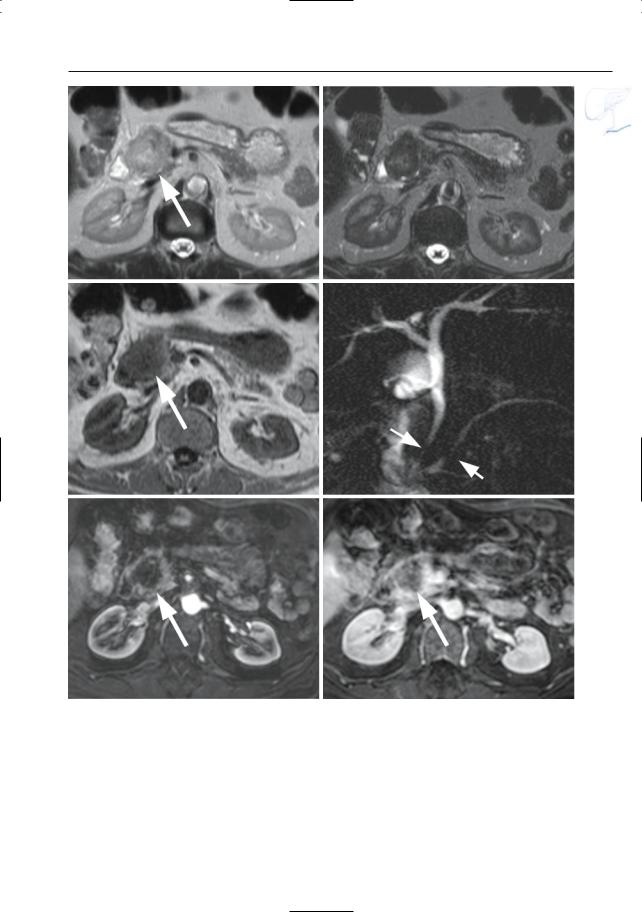
6 Pancreatic Ducts 377
a |
b |
c |
d |
e |
f |
Fig. 186 a–f. Axial T2-weighted HASTE images (TE 60 and 360) (a, b) and (c) axial T1-weighted image showing a focal lesion in pancreatic head (arrows): adenocarcinoma. The lesion is markedly hypointense to normal pancreatic tissue on the T1weighted image. d Projective image showing focal narrowing of the distal common bile duct and pancreatic duct,approximately at the same level (double
duct sign) (arrows). Note nearly normal size of proximal pancreatic duct, which is an unusual finding. e, f Axial contrast-enhanced T1-weighted VIBE images obtained in the pancreatic and late venous phase showing no enhancement of the tumor in the pancreatic phase and only minimal enhancement of the tumor in the late venous phase (arrow)

378 6.4 Malignant Tumors and Tumors with Malignant Potential
#187 Adenocarcinoma,
Ductal Changes
KEY FACTS: MRI
●Classical patterns of involvement of the main duct (Fig. 187a):
–(Apparent) occlusion (> 50% on MRCP)
–Stenosis, usually irregular with abrupt termination
–Dilation of the proximal main duct
–Double duct sign (Freeny et al. 1978; e.g., see #90, Fig. 187b–e, 188a, b); sometimes “four-segment sign” (Kim et al. 2002)
!● Side branches may be:
–Invisible (normal or obliterated)
–Dilated (obstruction; may appear like bizarre cystic pockets located adjacent to the tumor)
–Distorted/displaced
●Comments:
–Long strictures of the pancreatic duct, especially in the body or tail, are most commonly malignant (see, however,
# 164, # 167 and # 169); short strictures are more common in chronic alcoholic pancreatitis
–Projective images should be obtained routinely: subtle ductal changes may herald the presence of small tumors
References
Freeny PC, Bilbao MK, Katon RM (1976) “Blind” evaluation of endoscopic retrograde cholangiopancreatography (ERCP) in the diagnosis of pancreatic carcinoma: the “double duct” and other signs. Radiology 119 : 271–274
Kim JH, Kim MJ, Chung JJ et al. (2002) Differential diagnosis of periampullary carcinomas at MR imaging. Radiographics 22 : 1335–1352
Stewart E, Vennes J, Geenen J (1977) Atlas of endoscopic retrograde cholangiopancreatography. Mosby, St Louis, p 182
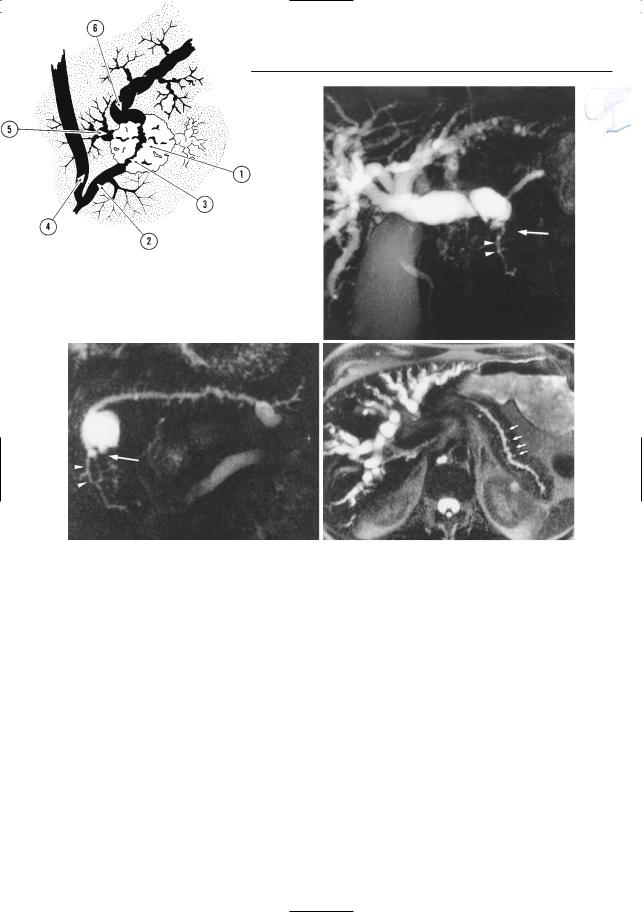
6 Pancreatic Ducts 379
a |
b |
|
c |
d |
Fig. 187. a Ductal changes in pancreatic cancer. The tumor (1) causes abrupt narrowing of the pancreatic duct (2). Note the irregular contours of the stricture (3). The common bile duct (4) may be normal or stenotic at the same level.Dilated side branches are seen adjacent to the tumor mass (5). The proximal pancreatic duct shows dilation (6). Note that necrotic areas within the tumor may appear as small “cysts.” In chronic pancreatitis, dilated side branches may be seen within an inflammatory mass, rather than adjacent to the mass (see # 167). (Reprinted with permission from Stewart et al. 1997). b–d Patient with cancer of pancreatic head. Projective images showing
marked dilation of intrahepatic bile ducts with abrupt termination (arrow in b) and slightly dilated pancreatic duct that exhibits narrowing at the same level (arrow in c). Note the rather homogeneous dilation of side branches in c and the presence of a dilated side branch in the pancreatic head that is displaced by the tumor (arrowheads in b,c). The cystic lesion in the pancreatic neck proved to be a benign mucinous neoplasm (incidental finding). d Same patient. Heavily T2-weighted axial image also showing rather uniform dilation of the side branches (arrows). The final diagnosis was infiltrating adenocarcinoma of the pancreatic neck
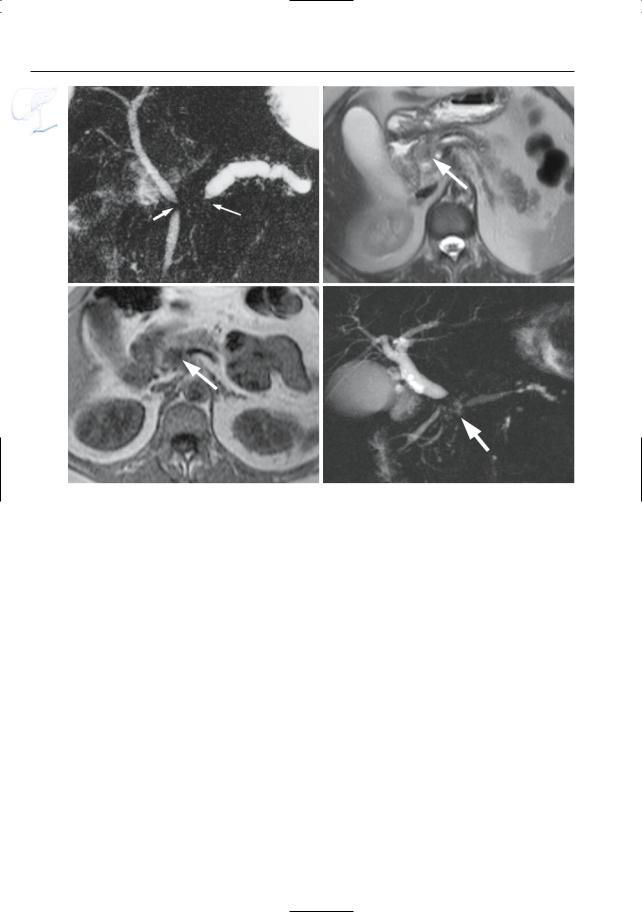
380 6.4 Malignant Tumors and Tumors with Malignant Potential
e |
f |
g |
h |
Fig. 187 a – j. (continued) e Projective image showing obliteration of the pancreatic duct associated with a short stricture of the common bile duct (double duct sign, arrows). f–h Axial T2-weighted HASTE image (f) and axial T1-weighted image (g) showing a small adenocarcinoma in the pancreatic head (arrow). As in most cases, the lesion is nearly iso-
intense to normal pancreatic parenchyma on the T2-weighted images and clearly T1-hypointense. h Projective image showing dilatation of the proximal main pancreatic and common bile duct with an abrupt obliteration of the ducts (arrow). The distal main pancreatic and common bile duct have a normal appearance (four segment sign)
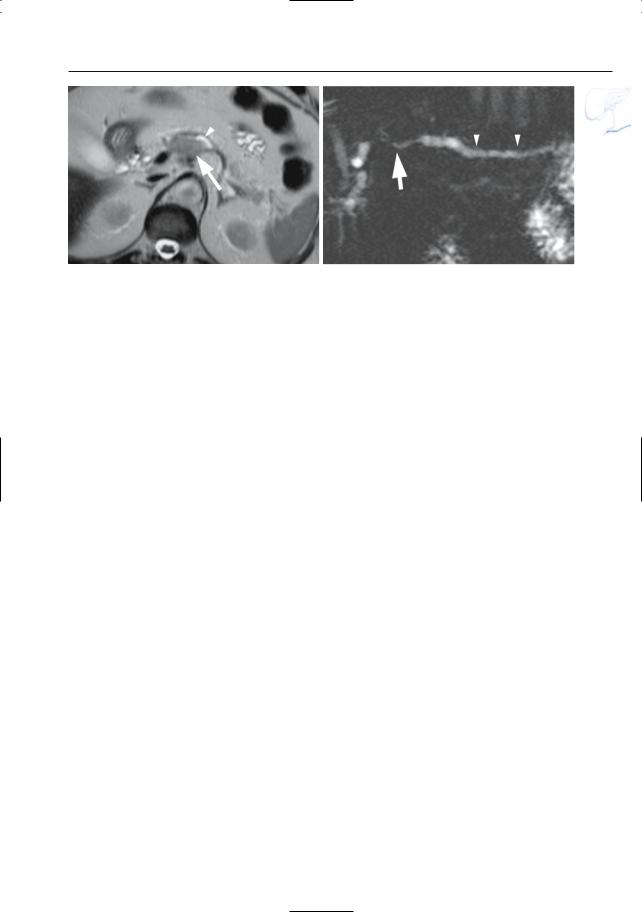
6 Pancreatic Ducts 381
i |
j |
Fig. 187 a – j. (continued) i, j Axial T2-weighted HASTE image (i) showing a small adenocarcinoma in the pancreatic body (arrow) with narrowing of the main pancreatic duct and proximal dilatation
(arrow–head). j Projective image showing dilatation of the proximal main pancreatic duct (arrowheads) with irregular narrowing in the pancreatic body
(arrow)

382 6.4 Malignant Tumors and Tumors with Malignant Potential
#188 Variant Morphology
of Adenocarcinoma (1):
Degree of Obstruction
KEY FACTS: MRI
●Since most pancreatic adenocarcinomas originate in the main pancreatic duct, ductal obstruction occurs early in the course of disease. MRI correlates:
–Dilation of the proximal main pancreatic duct
–More or less uniform dilation of the proximal side branches
–Variable degree of parenchymal atrophy
–Small intrapancreatic pseudocysts in 10%
!● However, the absence of proximal dilation does not rule out pancreatic carcinoma (Fig. 188c):
–Tumor may develop in a side branch and invade the main pancreatic duct only in a more advanced stage
–In patients with “dual” drainage (“bifid” ductal configuration, see also
# 136), obstruction of the ventral duct does not necessarily implicate dilation of the dorsal ducts
–Pancreas divisum (see # 190)
References
Fukumoto K, Nakajima M, Murakami K, Kawai K (1974) Diagnosis of pancreatic cancer by endoscopic cholangiopancreatography (ERCP). Am J Gastroenterol 60 : 210–213
Kim JH, Kim MJ, Chung JJ et al. (2002) Differential diagnosis of periampullary carcinomas at MR imaging. Radiographics 22 : 1335–1352
Muranaka T (1990) Morphologic changes in the body of the pancreas secondary to a mass in the pancreatic head. Analysis by CT. Acta Radiol 31 : 483–488
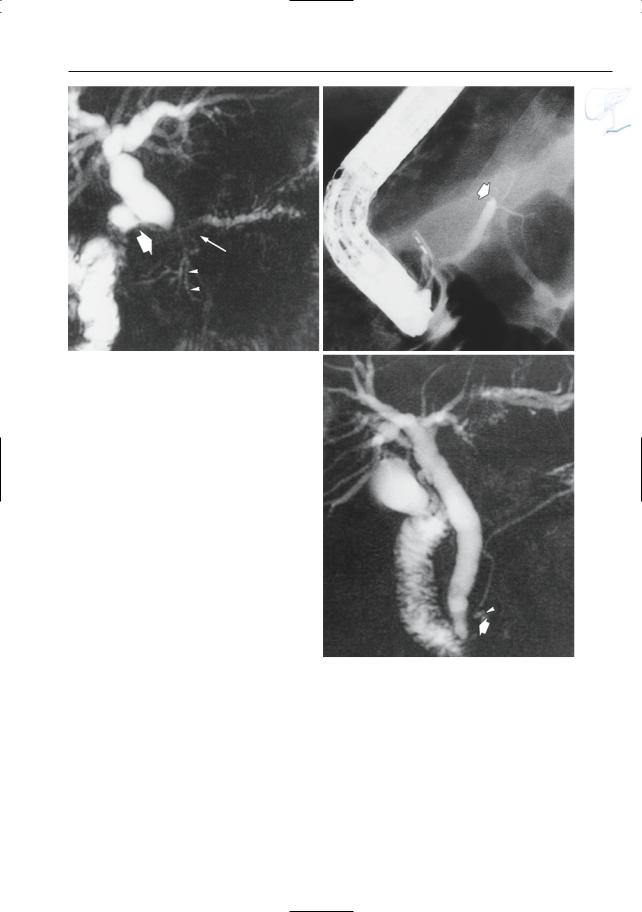
6 Pancreatic Ducts 383
a
Fig. 188 a, b. Patient with adenocarcinoma. a Projective MR image showing apparent occlusion of the pancreatic duct and bile duct (arrows).Also note the slightly dilated side branch in the pancreatic head (arrowheads). b ERCP showing occlusion of the main pancreatic duct (arrow). c Patient with a small adenocarcinoma in the pancreatic head. Projective MR image showing narrowing of the distal part of the pancreatic duct (arrow), without prestenotic dilation. Also note tumor necrosis (arrowhead). Bile duct dilation was caused by involvement of the papilla by the tumor
b
c

384 6.4 Malignant Tumors and Tumors with Malignant Potential
#189 Variant Morphology
of Adenocarcinoma (2):
Necrosis/Cystic Degeneration
KEY FACTS: MRI
●Adenocarcinomas commonly contain T2-hyperintense areas
●These may correspond to:
–Necrosis
–Cystic components
●Occasionally, cystic/necrotic areas may be quite large (cystic adenocarcinoma; Fig. 189)
●Differential diagnosis:
–Pseudocysts in chronic pancreatitis
–Other cystic tumors (e.g., mucinous neoplasms)
–Dilated side branches (see # 187)
●ERCP correlate of necrosis: extraductal extravasation of contrast material (38%) (Bilabao and Katon 1977)
References
Bilabao MK, Katon RM (1977) Neoplasms of the pancreas. In: Stewart E, Vennes J, Geenen J (eds) Atlas of endoscopic retrograde cholangiopancreatography. Mosby, St Louis, pp 181–192
Sahani D, Prasad S, Saini S, Mueller P (2002) Cystic pancreatic neoplasms: evaluation by CT and magnetic resonance cholangiopancreatography. Gastrointest Endoscopy Clin N Am 12 : 657–672
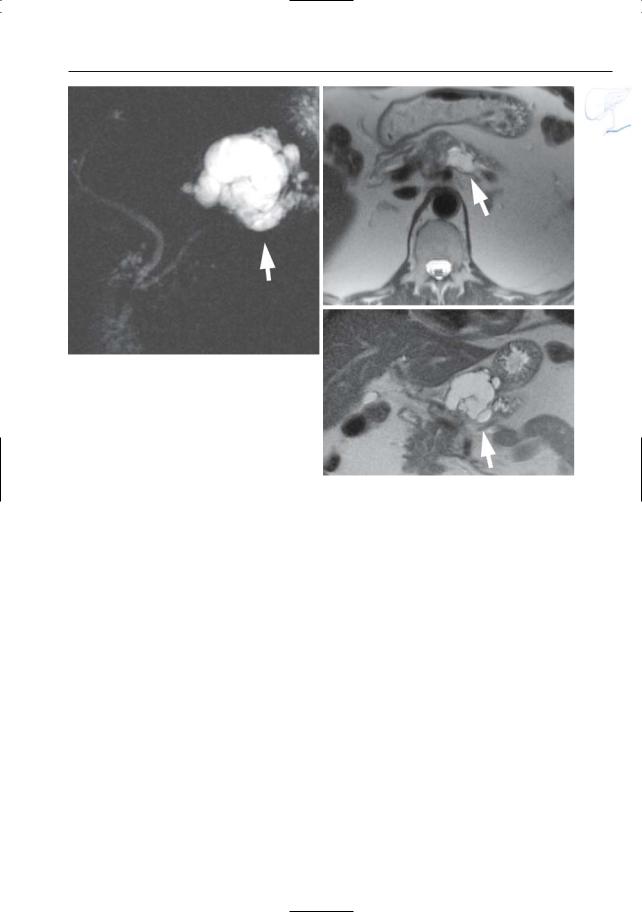
6 Pancreatic Ducts 385
a
Fig. 189 a–c. Projective image (a), axial (b) and coronal (c) T2-weighted HASTE images showing a large cystic lesion in the pancreatic tail (arrow) representing adenocarcinoma with marked cystic/ necrotic degeneration
b
c

386 6.4 Malignant Tumors and Tumors with Malignant Potential
#190 Adenocarcinoma
in Pancreas Divisum
Related topic: # 140 (pancreas divisum)
KEY FACTS: MRI
!● The “double duct sign” usually refers to concomitant stenosis or occlusion of the “main” pancreatic duct and common bile duct. It may, however, also refer to:
–Stenosis of the common bile duct and a side branch of the main pancreatic duct
–Stenosis of the common bile duct and the ventral duct (in pancreas divisum)
●Note: In complete pancreas divisum, obstruction of the ventral pancreatic
duct is typically not associated with ductal dilation in the body and tail, except in cases where the tumor extends to the minor papilla or accessory duct (Fig. 190)
References
Kelekis NL, Semelka RC (1995) Carcinoma of the pancreatic head area. Diagnostic imaging: magnetic resonance imaging. Rays 20 : 289–303
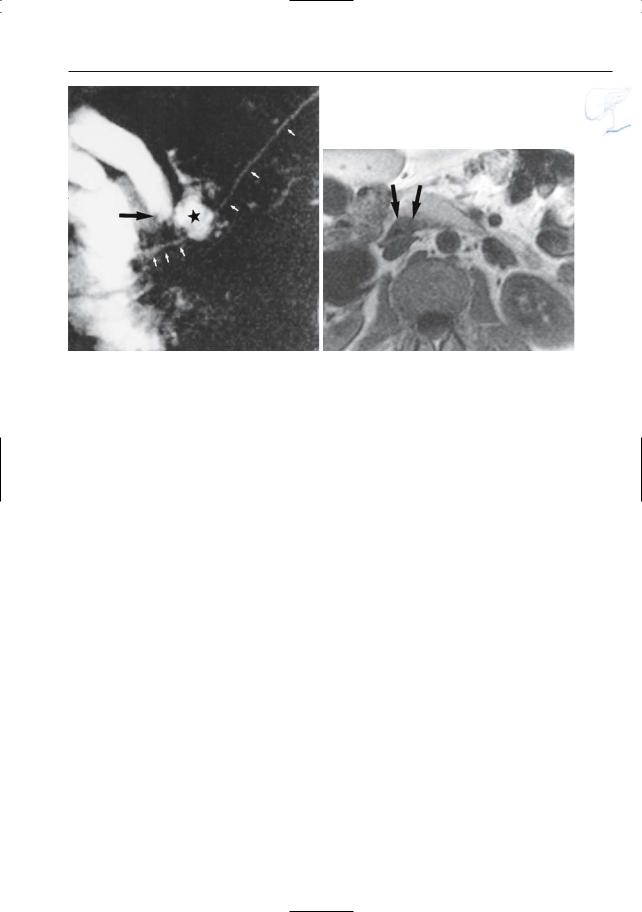
6 Pancreatic Ducts 387
a |
b |
Fig. 190 a, b. Projective image (a) showing a normal pancreatic duct in the body/tail with a patent duct of Santorini (small arrows). Note the dilation of the common bile duct with abrupt narrowing (arrow). Also note the marked obstructive dilation
of a side branch in the pancreatic head/neck (asterisk). b Axial T1-weighted image showing a small tumor in the posterior part of the pancreatic head (arrows). (Figure courtesy of C. Feys)

388 6.4 Malignant Tumors and Tumors with Malignant Potential
#191 Spread of Adenocarci-
noma (1): Vascular Invasion
KEY FACTS: DISEASE
●Invasion of peripancreatic vessels usually indicates unresectability
●Incidence: ± 33%
●Arterial encasement involves the superior mesenteric, splenic, celiac, hepatic, gastroduodenal, and left renal arteries, in descending order of frequency
●The veins most commonly affected are the splenic vein and portosplenic confluence
KEY FACTS: MRI
●Criteria for vascular invasion:
–Narrowing/occlusion
–Vessel partially or completely encircled by tumor (Loyer et al. 1996; Mitchell et al. 1987)
!● In patients with pancreatic head cancer invading or compressing the superior mesenteric vein, visualization of dilated peripancreatic veins (that act as collaterals) may be another useful sign of unresectability (Fig. 191; Hommeyer et al. 1995):
–Gastrocolic trunk
–Anterior superior pancreaticoduodenal vein
–Posterior superior pancreaticoduodenal vein
●Comments:
–In many cases, diagnosis of vascular invasion is evident on non-contrast- enhanced scans (Fig. 191)
–Dual-phase MRA can be used in conjunction with cross-sectional MRI and MRCP to provide a “complete” preoperative assessment of pancreatic neoplasms (Gaa et al. 1997)
References
Gaa J, Wendl K, Trede M, Georgi M (1997) New concepts in MR imaging of pancreatic carcinoma: the all-in-one approach. In: Oudkerk M, Edelman R (eds) High-power gradient MR-imaging. Blackwell Science, Berlin, pp 425–430
Hommeyer S, Freeny PC, Crabo LG (1995) Carcinoma of the head of the pancreas: evaluation of the pancreaticoduodenal veins with dynamic CT
– potential for improved accuracy in staging. Radiology 196 : 233–238
Loyer EM,David CL,Dubrow RA,Evans DB,Charnsangavej C (1996) Vascular involvement in pancreatic adenocarcinoma: reassessment by thin-section CT. Abdom Imaging 21 : 202–206
Mitchell DG,Hill MC,Cooper R et al.(1987) The superior mesenteric artery fat plane: is obliteration pathognomonic of pancreatic carcinoma? J Comp Assist Tomogr 11 : 247–253

6 Pancreatic Ducts 389
a |
b |
c |
d |
Fig. 191 a–d. Axial T1-weighted image (a) showing a large hypointense adenocarcinoma with clear extrapancreatic extension (arrow). b–d Axial contrastenhanced T1-weighted VIBE images obtained in the venous phase show dilatation of the gastrocolic venous trunc with mesenteric venous collaterals
[arrowheads in (b)].Also seen is displacement of the celiac trunc [large arrow in (c)], and invasion of the venous confluence and splenic vein [small arrows in (d)]. Note the hypovascular adenocarcinoma [open arrow in (d)]

390 6.4 Malignant Tumors and Tumors with Malignant Potential
#192 Spread of Adenocarci-
noma (2): Lymph Nodes
KEY FACTS: DISEASE
●Lymph node metastases are found in
± 50% of patients (Megibow et al. 1995)
●Lymph nodes most commonly involved:
– Cancer of the pancreatic head: retroperitoneal and superior pancreatic head groups
– Cancer of the pancreatic body and tail: superior body and head groups
KEY FACTS: MRI
●Signal intensity of (enlarged) lymph nodes relative to surrounding fat:
–T2 without fat suppression: variable, often more or less isointense
–T2 with fat suppression: variable, commonly hyperintense
–T1 without fat suppression: hypointense
–T1 with fat suppression: commonly isointense
–Contrast-enhanced images with fat suppression: hyperintense
● Limitations: |
|
|
|
|
|
|
! |
||
– |
Detection |
of slightly |
enlarged peri- |
|
|
pancreatic nodes may be difficult |
|
||
|
because of limitations of spatial reso- |
|||
|
lution (particularly in the third |
|||
|
dimension; volume averaging), multi- |
|||
|
plicity of small structures present in |
|||
|
the peripancreatic space (e.g., arter- |
|||
|
ies, veins), and subtle differences in |
|||
|
signal intensity from surrounding tis- |
|||
|
sues |
|
|
|
– |
Detection of micrometastases in nor- |
|||
|
mal-sized nodes is impossible |
|||
● Importance: |
detection |
of enlarged |
||
lymph nodes by imaging studies has little clinical relevance because, in the absence of other signs of non-resectabil- ity, it does not represent a contra-indica- tion for surgery
References
Kelekis NL, Semelka RC (1997) MRI of pancreatic tumors. Eur Radiol 7 : 875–886
Megibow AJ, Zhou XH, Rotterdam H et al. (1995) Pancreatic adenocarcinoma: CT versus MR imaging in the evaluation of resectability – report of the Radiology Diagnostic Oncology Group. Radiology 195 : 327–332
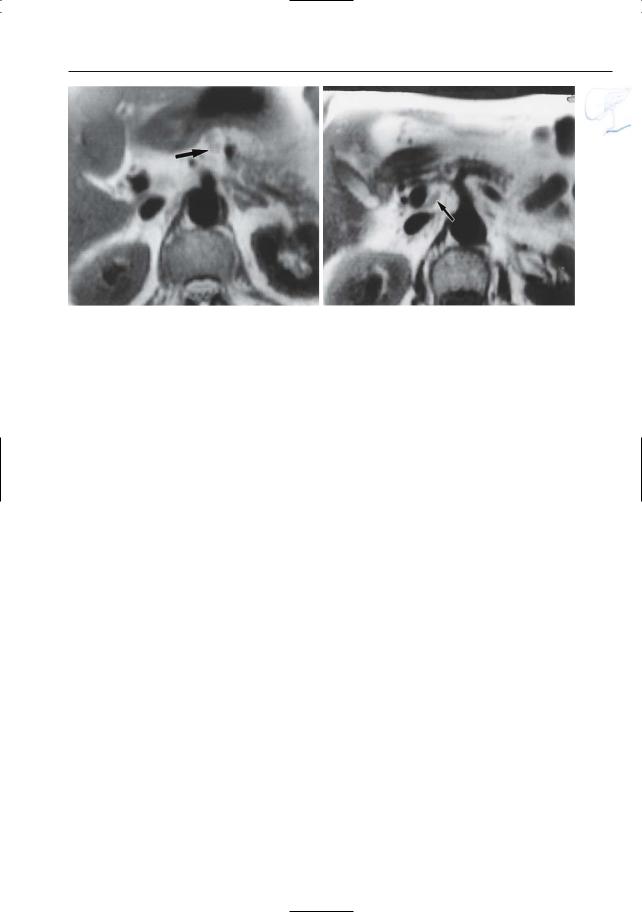
6 Pancreatic Ducts 391
a |
b |
Fig. 192 a, b. Patient with pancreatic carcinoma. Images obtained using the “black blood” technique showing several enlarged a superior body and
b portocaval nodes (arrows). Note that these nodes were invisible on the classical HASTE sequence

392 6.4 Malignant Tumors and Tumors with Malignant Potential
#193 Spread of Adenocarci-
noma (3): Distant Metastases
KEY FACTS: DISEASE
●Incidence of hematogenous metastases in autopsy series: 85%–95%
●Location (in descending order of frequency): liver, lungs, adrenals, kidneys, bones
KEY FACTS: MRI
–T2: (minimally) hyperintense with or without central necrosis
–Hypointense on contrast-enhanced scans, sometimes with peripheral rim enhancement
●Peritoneal metastases are usually not directly visualized; presence of ascites in patients with a pancreatic neoplasm and without signs of cirrhosis or portal vein thrombosis may be an indirect sign (Fig. 1)
●Hepatic metastases of pancreatic adenocarcinoma have a nonspecific appearance (see also #60):
– T1: hypointense
References
Baert AL, Rigauts H, Marchal G (1994) Ductal adenocarcinoma. In: Baert AL (ed) Radiology of the pancreas. Springer, Berlin Heidelberg New York, pp 129–172
Kelekis NL, Semelka RC (1997) MRI of pancreatic tumors. Eur Radiol 7 : 875–886
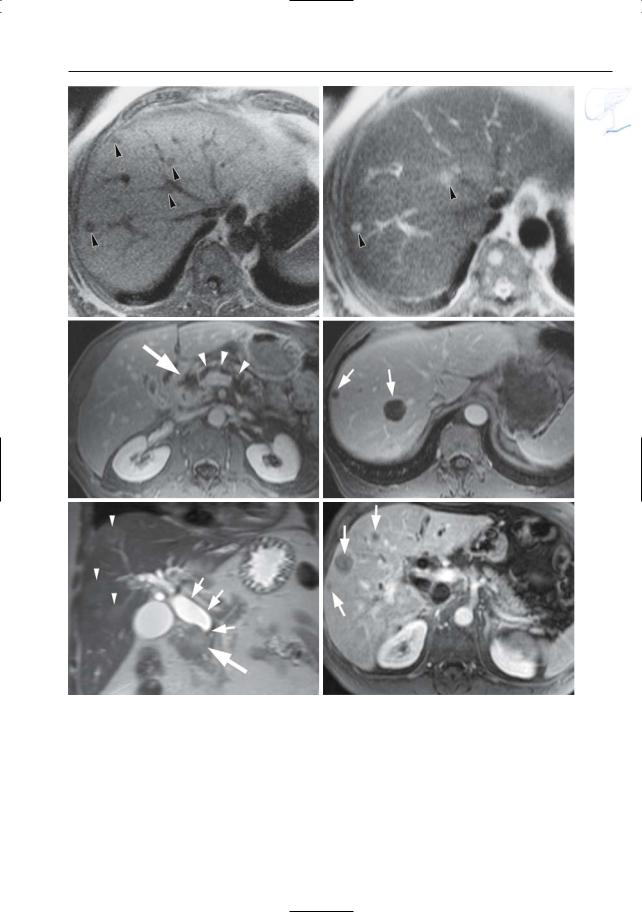
6 Pancreatic Ducts 393
a |
b |
c |
d |
e |
f |
Fig. 193 a, b. a T1and b T2-weighted images showing hepatic metastases as hypoand slightly hyperintense, respectively (arrowheads). Note that the T1weighted image shows more lesions. c, d Axial contrast-enhanced T1-weighted VIBE images obtained in the portovenous phase showing a hypoenhancing adenocarcinoma in the pancreatic head [large arrow in (c)], with retro-obstructive dilatation of the main pancreatic duct [arrowheads in (c)], and two rim-enhancing liver metastases in the right lobe [small arrows in (d)]. Because of the subtle enhance-
ment, these lesions could be mistaken for cysts. e, f Coronal T2-weighted HASTE image (e) showing a hyperintense adenocarcinoma in the pancreatic head (large arrow) with obliteration and proximal dilatation of the common bile duct (small arrows), and multiple slightly hyperintense hepatic metastases (arrowheads). f Axial contrast-enhanced T1-weighted VIBE image obtained in the venous phase confirming the presence of multiple metastatic lesions in the liver
(arrows)

394 6.4 Malignant Tumors and Tumors with Malignant Potential
#194 Adenocarcinoma
with Retro-obstructive
Pancreatitis
Related topic: # 168 (chronic obstructive pancreatitis)
KEY FACTS: DISEASE
●Ductal obstruction by adenocarcinoma may cause:
–Chronic obstructive pancreatitis (see
# 168)
–Acute pancreatitis
●Note: Pancreatic cancer may also develop in patients with preexisting chronic pancreatitis (occurring in 2–4% of patients)
KEY FACTS: MRI
!● Pancreatitis associated with adenocarcinoma may cause diagnostic problems for several reasons:
–Ductal changes in chronic pancreatitis may be so dominant that the associated carcinoma is overlooked
–Peripancreatic inflammatory changes in acute pancreatitis may jeopardize the diagnostic quality of projective MR images
–Tumor detection may be difficult due to loss of the normal hyperintensity of surrounding pancreatic tissue on T1weighted images
●Signs of pancreatitis indicate the need for obtaining immediate postcontrast gadolinium-enhanced scans for tumor detection (Fig. 194)
●Signs suggestive of carcinoma (see also
# 167):
–Focal irregular ductal stenosis in a duct with an otherwise normal appearance (not absolute, see # 1)
–Length of stenosis: > 1–2 cm (idem)
–Abrupt termination of stenosis (idem)
–Double duct sign (not absolute, see
# 164)
–Focal markedly T1-hypointense mass, with parenchyma with an otherwise normal appearance
–Markedly hypovascular solid focal mass causing ductal obstruction
References
Delmaschio A, Vanzulli A, Sironi S et al. (1991) Pancreatic cancer versus chronic pancreatitis: diagnosis with CA 19-9 assessment, US, CT, and CTguided fine-needle biopsy. Radiology 178 : 95–99 Kelekis NL, Semelka RC (1997) MRI of pancreatic
tumors. Eur Radiol 7 : 875–886
Shemesh E, Czerniak A, Nass S, Klein E (1990) Role of endoscopic retrograde cholangiopancreatography in differentiating pancreatic cancer coexisting with chronic pancreatitis. Cancer 65 : 893–896
!
!
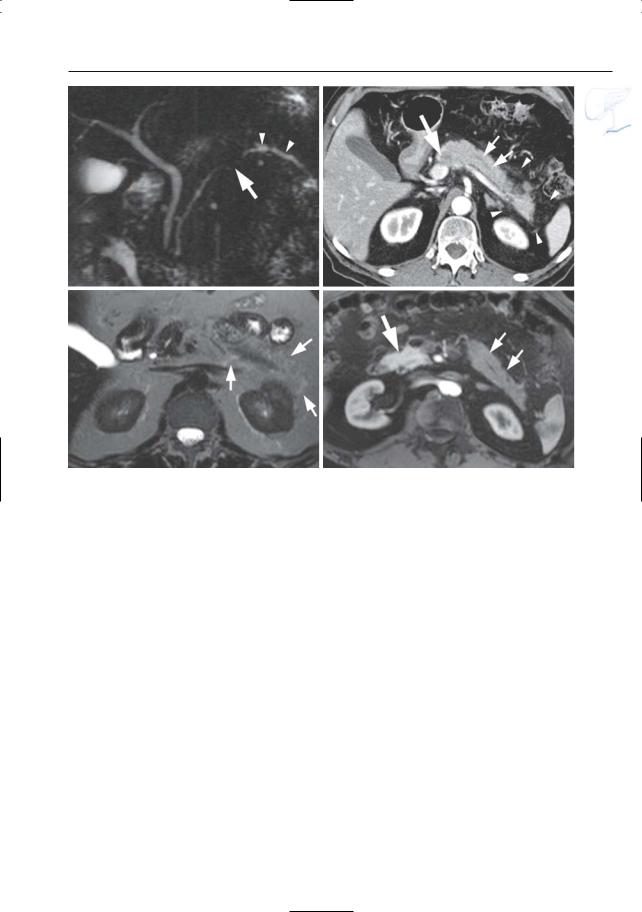
6 Pancreatic Ducts 395
a |
b |
c |
d |
Fig. 194 a–d. Patient with adenocarcinoma and retro-obstructive pancreatitis. a Projective image showing a stenosis of the pancreatic duct (arrow) with proximal dilatation (arrowheads). b CT image showing a small pancreatic tumor (large arrow), prestenotic duct dilatation (small arrows),and subtle peripancreatic infiltration (arrowheads). c Axial T2weighted HASTE image (TE 360) showing slightly
increased signal intensity of the fat around pancreatic tail. d Axial contrast-enhanced T1-weighted VIBE image obtained in the pancreatic phase showing decreased enhancement of the pancreatic tail (small arrows) when compared to the head (large arrow). The findings in (c) and (d) point to the presence of retro-obstructive pancreatitis. Final diagnosis: adenocarcinoma

396 6.4 Malignant Tumors and Tumors with Malignant Potential
#195 Recurrent Adenocarcinoma
KEY FACTS: GENERAL
●Incidence: not rare:
–Only 14% of patients with adenocarcinoma have tumor confined to the pancreas
–Approximately 35% of metastatic lymph nodes cannot be removed during surgery; similarly, tumors encasing retroperitoneal vessels can only partially be removed
●Location: most commonly in close proximity to the superior mesenteric artery or celiac trunk
KEY FACTS: MRI
●Typical feature: infiltrating mass surrounding and encasing the superior mesenteric artery and/or celiac trunk
References
Coombs RJ, Zeiss J, Howard JM, Thomford NR, Merrick HW (1990) CT of the abdomen after the Whipple procedure: value of depicting postoperative anatomy, surgical complications and tumor recurrence. AJR Am J Roentgenol 154 : 1011–1014

6 Pancreatic Ducts 397
a |
b |
Fig. 195 a, b. Patient who underwent a Whipple operation for carcinoma in the pancreatic head. a T2-weighted image showing soft tissue mass (arrows) between the superior mesenteric artery
and the aorta. b CT image obtained at a more caudal level also showing soft tissue cuff around the superior mesenteric artery (arrowheads)

398 6.4 Malignant Tumors and Tumors with Malignant Potential
#196 Secondary Pancreatic Tumors
Related topics: #60 (intrahepatic bile ducts: metastases), #91 (extrahepatic bile duct: involvement by other extrabiliary neoplasms)
KEY FACTS: DISEASE
●Most common secondary pancreatic tumors:
–Lymphoma
–Metastases from breast cancer, lung cancer (24% of patients with small cell lung cancer), cancer of the colon, renal cell carcinoma, and malignant melanoma
●Usually end-stage disease
KEY FACTS: MRI
●Pancreatic duct:
–Typically no involvement or displacement only
–Narrowing may occur but is less frequent
●Parenchyma: usually multiple locations
●Specific features:
–Melanoma metastases may be T1hyperintense
–Renal cell carcinoma metastases are typically hypervascular (differential diagnosis with endocrine tumors)
●Key elements: clinical history/locations in other organs
References
Ehrlich A, Stalder G, Geller W, Sherlock P (1968) Gastrointestinal manifestations of malignant lymphoma. Gastroenterology 54 : 1115–1121
Roland CF, Van Heerden JA (1989) Nonpancreatic primary tumors with metastases to the pancreas. Surg Gynecol Obstet 168 : 345–347
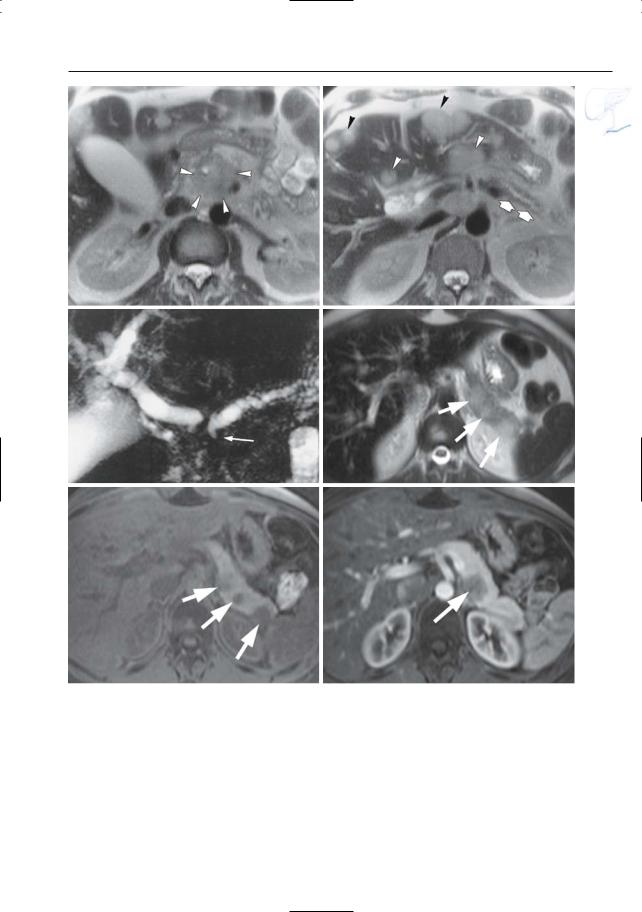
6 Pancreatic Ducts 399
a |
b |
c |
d |
e |
f |
Fig.196 a – c. Patient with lung cancer. a, b T2weighted images showing a large mass in the pancreatic head (arrowheads), atrophy of the pancreatic tail (arrows), and multiple hepatic metastases (arrowheads). c Projective MR image showing double duct sign (arrow), which is an unusual finding in patients with pancreatic metastases. d–f Patient with esophageal myosarcoma and pancreatic metastases.
Axial T2-weighted HASTE image (d) and axial T1 weighted image (e) showing multiple focal lesions in the pancreatic tail (arrows). Note the peripheral location of these masses and the absence of dilatation of the pancreatic duct. f Axial contrast-enhan- ced T1-weighted VIBE image (different position) obtained in the pancreatic phase showing poor vascularization of the metastatic lesion (arrow)

400 6.4 Malignant Tumors and Tumors with Malignant Potential
#197 Malignant Neuroendocrine
Tumors
Related topic: # 177 (benign neuroendocrine tumors)
KEY FACTS: DISEASE
●Incidence of malignancy with respect to subtype: see Table 197
●Other features:
–Gastrinomas found in patients with type-1 multiple endocrine neoplasia syndrome are less likely to be malignant than isolated gastrinomas
–Larger tumors (> 2 cm) are more commonly malignant
KEY FACTS: MRI
●Secreting tumors: see # 177 (no morphologic features to distinguish between benign and malignant tumors)
●Nonsecreting tumors are usually large and centrally necrotic
● Note: Hepatic metastases of gastrinoma |
|
|
! |
||
typically have a very high signal inten- |
||
sity on T2-weighted images and, there- |
|
|
fore, may mimic hemangiomas. Solu- |
|
|
tion: delayed contrast-enhanced MRI |
|
|
(Berger et al. 1996): |
|
–Gastrinoma metastases: hypoor isointense
–Hemangiomas: hyperintense
References
Berger JF, Laissy JP, Limot O et al. (1996) Differentiation between multiple liver hemangiomas and liver metastases of gastrinomas: value of enhanced MRI. J Comp Assist Tomogr 20 : 349–355 Marcos HB, Libutti SK, Alexander HR, et al. (2002) Neuroendocrine tumors of the pancreas in von Hippel-Lindau disease: spectrum of appearances at CT and MR imaging with histopathologic
comparison. Radiology 225 : 751–758
Van Hoe L, Vanbeckevoort D, Baert AL (1997) Endocrine tumors of the pancreas: computed tomography and magnetic resonance imaging. Chir Gastroenterol 13 : 301–306

6 Pancreatic Ducts 401
Table 197. Incidence of malignancy in neuroendocrine tumors
Tumor |
Relative frequency (%) |
Malignant (%) |
|
|
|
Insulinoma |
56 |
5–10 |
Gastrinoma |
21 |
60 |
Glucagonoma |
2.3 |
80 |
Vipoma |
1.8 |
60 |
Nonfunctioning tumors |
15 |
80–100 |
|
|
|
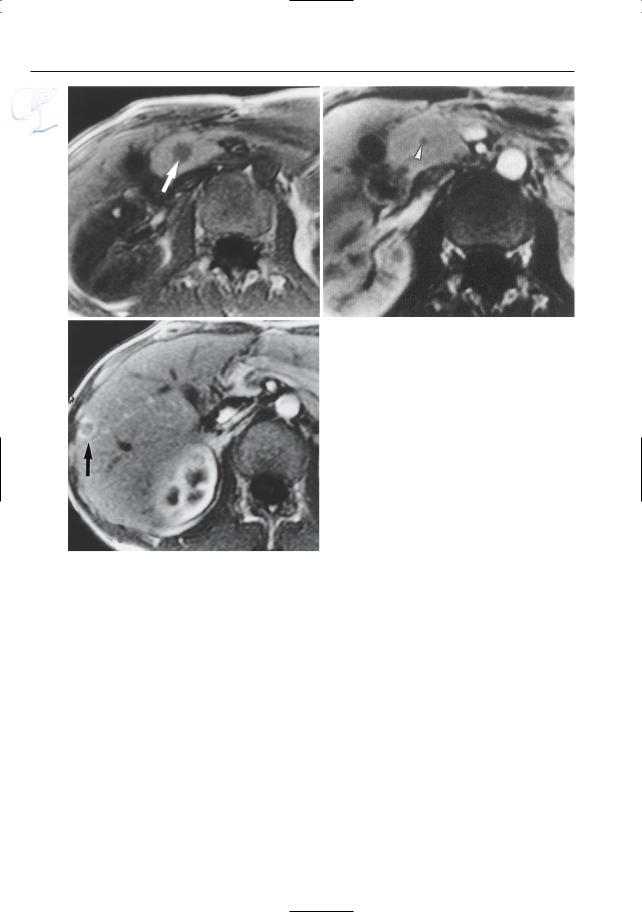
402 6.4 Malignant Tumors and Tumors with Malignant Potential
a |
b |
|
Fig. 197 a – c. Patient with metastatic gastrinoma. |
|
|
a T1-weighted image showing a hypointense lesion |
|
|
in the pancreatic head, corresponding to a gastri- |
|
|
noma (arrow). b Contrast-enhanced fat-suppressed |
|
|
T1-weighted image only showing the nonenhancing |
|
|
central part of the tumor (arrowhead). c Contrast- |
|
|
enhanced image obtained at a more cranial level |
|
c |
showing liver metastasis with typical rim enhance- |
|
ment (arrow) |
||
|
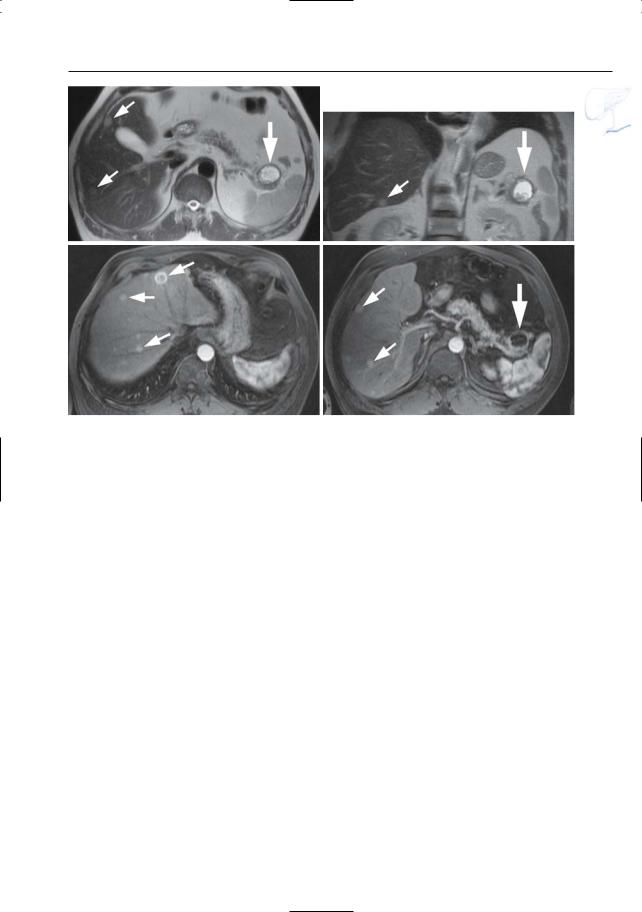
6 Pancreatic Ducts 403
d |
e |
f |
g |
Fig. 197 d– g. Patient with a malignant cystic neuroendocrine tumor with hypervascular liver metastases. d, e Axial and coronal T2-weighted HASTE images showing a hyperintense cystic mass in the pancreatic tail with a thick irregular wall (large arrow), and multiple T2-hyperintense liver lesions
(small arrows). f, g Axial contrast-enhanced T1weighted VIBE images obtained in the arterial phase showing strong uptake of contrast medium in these lesions (small arrows). Note the nonenhancing cystic neuroendocrine tumor in the pancreatic tail [large arrow in (g)]
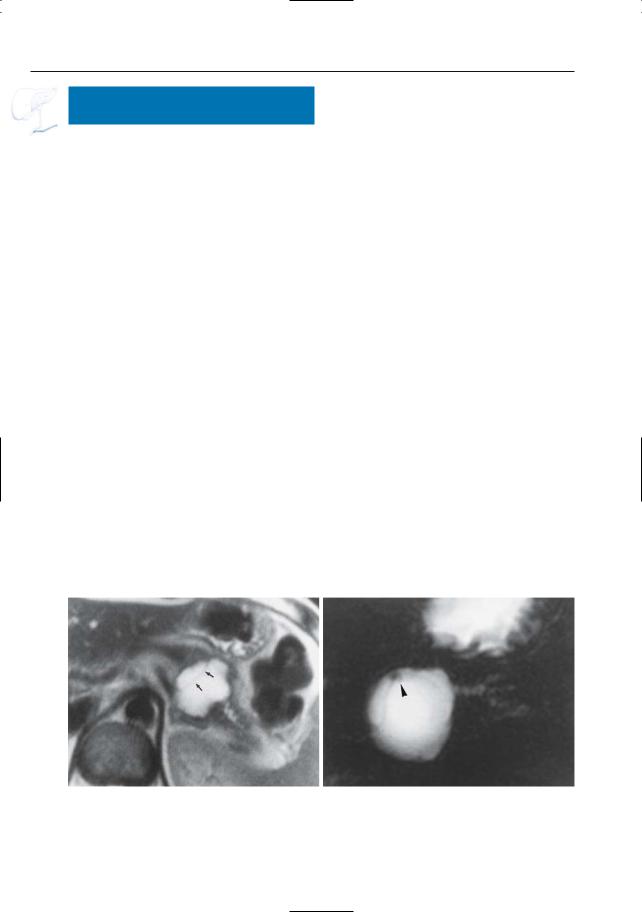
404 6.4 Malignant Tumors and Tumors with Malignant Potential
#198 Mucinous Pancreatic
Neoplasm (Peripheral Type)
Related topics: # 175, 176 (serous cystadenoma), # 199 (intraductal neoplasm)
KEY FACTS: DISEASE
●Synonyms:
–Macrocystic pancreatic neoplasm
–Mucinous cystadenoma/cystadenocarcinoma
●Cystic lesions lined by columnar, mucinproducing cells
●Macroscopic appearance:
–Unilocular or multilocular
–Cystic components usually greater than 2 cm in diameter
–Papillary protrusions may be seen
–Sometimes peripheral calcifications
●To be distinguished from intraductal mucinous neoplasms (see # 199)
●Mean age: 50 years
a
●Ratio of women to men: 6 : 1–9 : 1
●Location: 85% in the pancreatic tail
●Usually large
●All tumors are malignant or have malignant potential
●Local recurrence is common
KEY FACTS: MRI (FIG. 198)
●Unilocular or multilocular cystic lesion
●Cysts greater than 2 cm in diameter
●Signal intensity of contents of cystic spaces: reflects varying concentrations of mucin
–Usually like fluid
–Sometimes T1-hyperintense (high concentration of mucin)
–Sometimes lower signal intensity in dependent portions on T2 (“layering”)
–The intensities may vary in different loculi
●No enhancing components
●Malignant tumors have a propensity for invasion of local organs and vessels
b
Fig. 198 a, b. a Axial T2-weighted image showing a cystic lesion in the pancreatic body/tail, containing a septum (arrows). b Projective image showing a
septum and small mural nodule (arrowhead), which would be unusual for a (pseudo-)cyst.
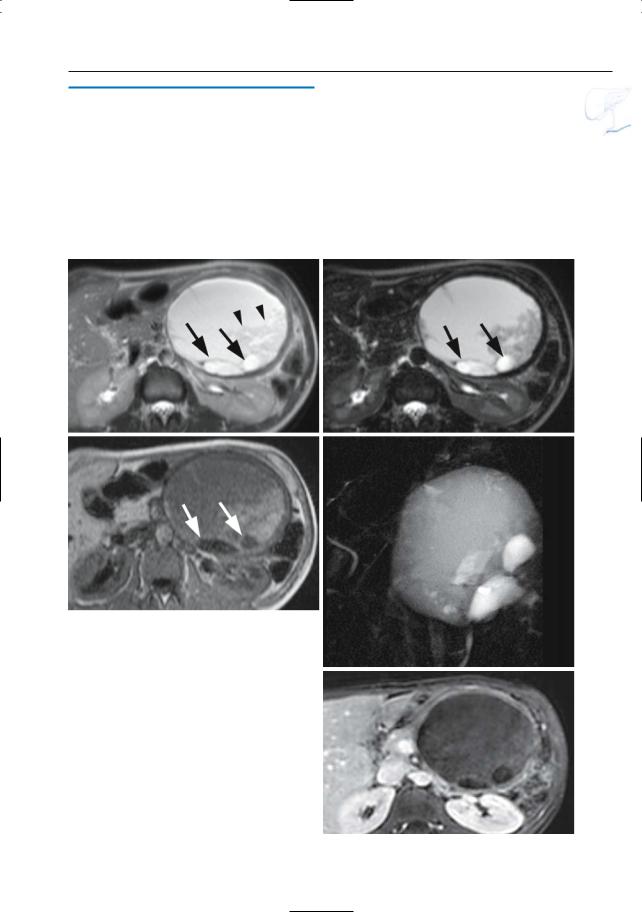
6 Pancreatic Ducts 405
References
Compagno J, Oertel JE (1978) Mucinous cystic neoplasms of the pancreas with overt and latent malignancy (cystadenocarcinoma and cystadenoma): a clinicopathologic study of 41 cases. Am J Clin Pathol 69 : 573–580
Kim YH, Saini S, Sahani D, Hahn PF, Mueller P, Auh Y (2005) Imaging diagnosis of cystic pancreatic lesions: pseudocyst versus nonpseudocyst. RadioGraphics 25 : 671–685
c
e
Fig. 198 c–g. c Axial T2-weighted HASTE image (TE 60) showing a large cystic lesion in the pancreatic body/tail with two hyperintense components (arrows) and debris (arrowheads). d–f Axial T2weighted HASTE image (TE 360), axial T1-weighted image and projective image clearly show the different signal intensities in the different components of the lesion (arrows). g Axial contrast-enhanced T1weighted VIBE image obtained in the venous phase showing no internal enhancing components
Minami M,Itai Y,Ohtono K,Yoshida H,Yoshikawa K, Lio M (1989) Cystic neoplasms of the pancreas: comparison of MR imaging with CT. Radiology 171 : 53–56
Sahani D, Prasad S, Saini S, Mueller P (2002) Cystic pancreatic neoplasms: evaluation by CT and magnetic resonance cholangiopancreatography. Gastrointest Endoscopy Clin N Am 12 : 657–672
d
f
g

406 6.4 Malignant Tumors and Tumors with Malignant Potential
#199 Intraductal Papillary
Mucinous Tumor (IPMT)
Related topic: # 198 (mucinous pancreatic neoplasm, peripheral type)
KEY FACTS: DISEASE
●Mucin-producing tumor of intraductal origin
●No preponderance for men or women
●Belongs to the group of mucinous pancreatic tumors. Classification (Itai and Ohtomo 1996):
–Branch duct type: mucin-secreting intraductal tumor usually located in the uncinate process and causing localized dilation of a side branch
–Main duct type: mucin-secreting intraductal tumor characterized by dilation of the main pancreatic duct
●Like tumors of the peripheral type, these tumors have malignant potential
●The prognosis depends on the presence or absence of local invasion
KEY FACTS: MRI
●General remarks:
–The mucin-secreting tumor is often too small to be visualized; the hallmark of the disease is marked focal or diffuse ductal dilation
–Mucin has a very high signal intensity on T2-weighted images and cannot usually be differentiated from fluid
!● Typical appearance of the branch duct type (Fig. 199):
–“Polycystic” mass in the uncinate process, actually representing focally dilated side branches filled with mucin
–Differential diagnosis: pseudocyst(s)
●Typical appearance of the main duct ! type:
–Usually marked global dilation of the main pancreatic duct without a demonstrable cause of obstruction
–Clue to diagnosis on ERCP: endoscopic visualization of a protruding gelatinous substance (mucin)
–Differential diagnosis: other diseases causing ductal dilation (ductal or orificial stenosis, lithiasis)
●Signs of malignancy (Irie et al. 2000)
–Branch duct type: filling defects visible at MRI; main pancreatic duct dilation
–Main duct type: filling defects visible at MRI; diffuse main pancreatic duct dilatation greater than 15 mm
References
Irie H, Honda H, Aibe H et al. (2000) MR cholangiopancreatographic differentiation of benign and malignant intraductal mucin-producing tumors of the pancreas. AJR Am J Roentgenol 174 : 1403–1408
Irie H, Yoshimitsu K, Aibe H et al. (2004) Natural history of pancreatic intraductal papillary mucinous tumor of branch duct type: follow-up study by magnetic resonance cholangiopancreatography. J Comput Assist Tomogr 28 : 117–122
Itai Y, Ohtomo K (1996) Cystic tumors of the pancreas. Eur Radiol 6 : 844–850
Itai Y, Ohhashi K, Nagai H et al. (1986) ‘Ductectatic’ mucinous cystadenoma and cystadenocarcinoma of the pancreas. Radiology 161 : 697–700
Lim JH (2003) Cholangiocarcinoma: morphologic classification according to growth pattern and imaging findings. AJR Am J Roentgenol 181 : 819–827
Procacci C, Graziani R, Bicego E et al. (1996) Intraductal mucin-producing tumors of the pancreas: imaging findings. Radiology 198 : 249–257
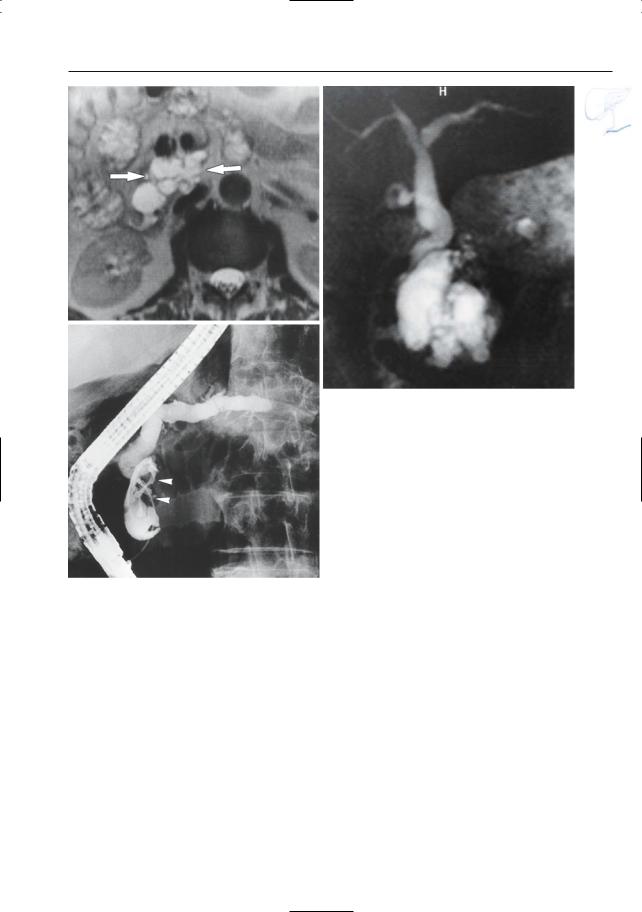
6 Pancreatic Ducts 407
a
b
Fig. 199 a–c. a Moderately T2-weighted image showing “polycystic” mass in the uncinate process (arrows), representing a conglomerate of dilated side branches. b Projective MR image showing compression of the common bile duct. c ERCP image showing a dilated side branch containing a large filling defect (mucin plug; arrowheads). Note that the mucin plug is invisible on MRI (same intensity as fluid). Surgery was not performed in this patient because of medical contraindications.
c One year later, he presented with a large inoperable malignant mass in the pancreatic head
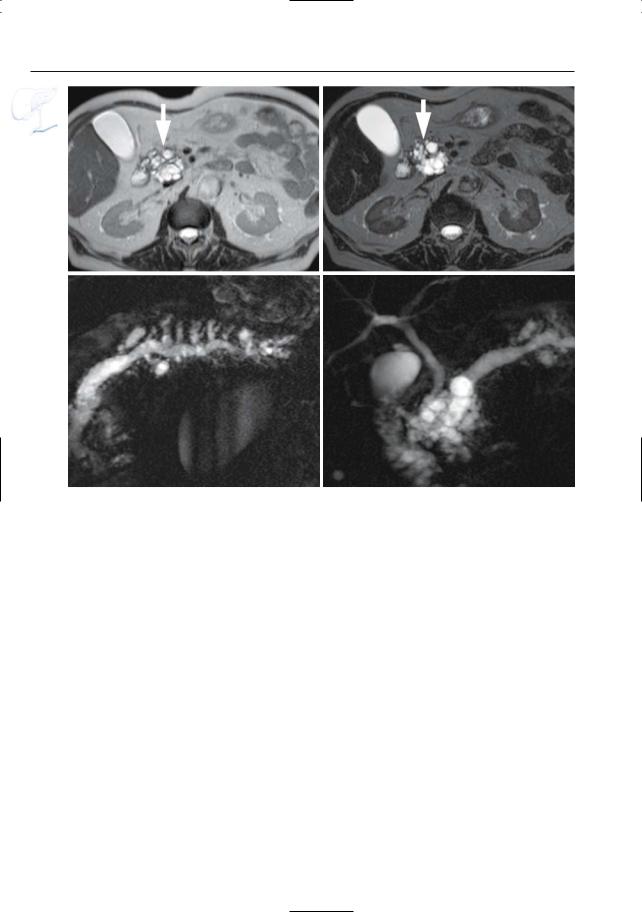
408 6.4 Malignant Tumors and Tumors with Malignant Potential
d |
e |
f |
g |
Fig. 199 d–g. IPMT branch duct type with associated dilatation of main duct. (d, e) Axial T2-weighted HASTE image (TE 60 and 360) showing a “polycystic” mass in the pancreatic head (arrow), represen-
ting a conglomerate of dilated side branches. f, g Projective images showing marked global dilatation of the main pancreatic duct and all of the side branches without a demonstrable cause of obstruction
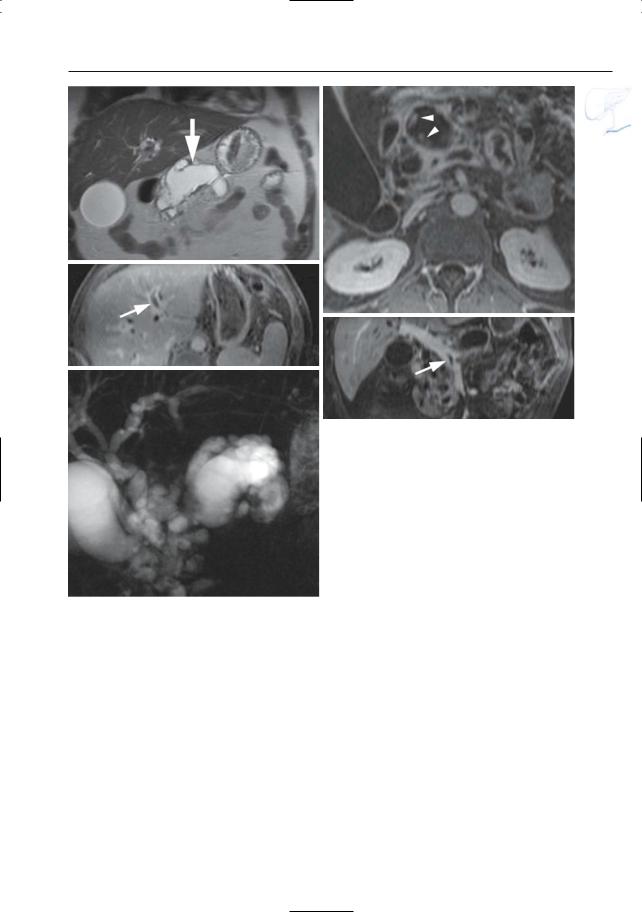
6 Pancreatic Ducts 409
h
i
j
k
Fig. 199 h–l. Patient with a malignant IPMT of the main duct type.h Coronal T2-weighted HASTE image showing marked ductal dilatation (arrow). Axial (i, j) and coronal (k) reconstructed contrast-enhanced T1weighted VIBE images showing multiple contrast enhancing papillary protrusions in one of the larger “cystic” components due to malignant degeneration [arrowheads in (i)]. Note the presence of mucus in the main and left portal vein secondary to vascular invasion [arrows in (j, k)].l Projective image showing marked cystic pancreatic duct dilatation in the pancreatic
l head and secondary intraand extrahepatic biliary duct dilatation due to mass-effect
